Divaricate means branching, or having separation or a degree of separation. The angle between branches is wide. [1]
Divaricate means branching, or having separation or a degree of separation. The angle between branches is wide. [1]

In botany, the term is often used to describe the branching pattern of plants. Plants are said to be divaricating when their growth form is such that each internode diverges widely from the previous internode, producing an often tightly interlaced shrub or small tree. [3] Of the 72 small leaved shrubs found on the Banks Peninsula, for example, some 38 are divaricating. [4]
| | This section needs expansion. You can help by adding to it. (January 2014) |

Tubers are a type of enlarged structure used as storage organs for nutrients in some plants. They are used for the plant's perennation, to provide energy and nutrients for regrowth during the next growing season, and as a means of asexual reproduction. Stem tubers form thickened rhizomes or stolons ; well known species with stem tubers include the potato and yam. Some writers also treat modified lateral roots under the definition; these are found in sweet potatoes, cassava, and dahlias.

In biology, stolons, also known as runners, are horizontal connections between parts of an organism. They may be part of the organism, or of its skeleton. Typically, animal stolons are exoskeletons.
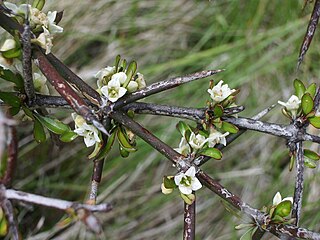
Discaria toumatou, commonly called matagouri, tūmatakuru or wild Irishman, is a tangle-branched thorny plant endemic to New Zealand.
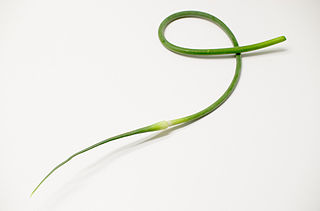
In botany, a scape is a peduncle arising from a subterranean or very compressed stem, with the lower internodes very long and hence few or no bracts except the part near the rachis or receptacle. Typically it takes the form of a long, leafless flowering stem rising directly from a bulb, rhizome, or similar subterranean or underwater structure.
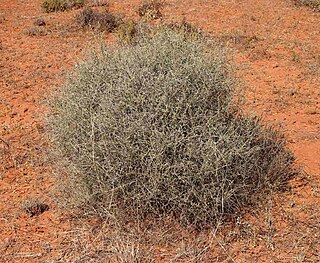
Maireana aphylla, also known as cotton bush or leafless bluebush, is a leafless shrub that is endemic to Australia. It is usually rounded in form and grows to around 1.5 metres in height.
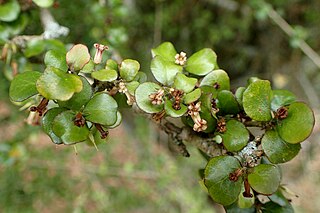
Pittosporum obcordatum, commonly called heart-leaved kohuhu or heart-leaved kohukohu or kohukohu, is a species of plant in the Pittosporaceae family. It is endemic to New Zealand, and exists both in North Island and South Island.

Prunus fasciculata, also known as wild almond, desert almond, or desert peach is a spiny and woody shrub producing wild almonds, which is native to western deserts of North America.

Allenrolfea occidentalis, the iodine bush, is a low-lying shrub of the Southwestern United States, California, Idaho, and northern Mexico.

Coprosma rhamnoides is an endemic shrub in New Zealand. It forms a small shrub up to 2 m tall. The leaves are very small, simple and variable in shape. The inconspicuous flowers are unisexual and believed to be wind pollinated. It is widespread in occurrence and can be the dominant small leaved divaricating shrub in some locations
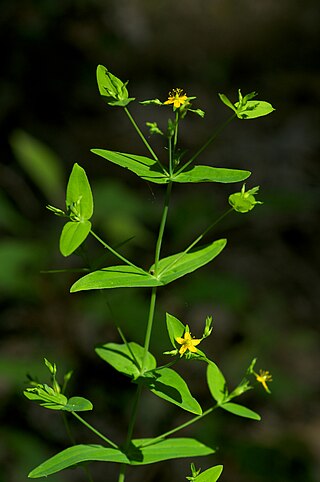
Hypericum mutilum is a species of St. John's wort known by the common name dwarf St. John's wort. It is native to parts of North America and is present in other parts as an introduced species. It is an annual or perennial herb taking a multibranched erect form up to about 60 centimeters tall. The oval green leaves are one or two centimeters long and are covered in tiny glands. The inflorescence is a compound cyme of tiny flowers. H. mutilum subsp. mutilum and subsp. boreale have a diploid number of 16, and H. mutilum subsp. boreale can have a diploid number of 18.

Coprosma propinqua is a New Zealand plant of the genus Coprosma in the family Rubiaceae. Its Māori name is mingimingi, a name which is also applied to closely related species such as C. dumosa, C. rhamnoides, C. virescens and C. crassifolia. It is a small-leaved shrub or tree which grows 3 to 6 metres high. It has divaricating branches, and is common in swampy forest, in scrub, along stream banks and in stony places. It has a wide distribution, ranging from Mangonui in the North Island as far south as Stewart Island. It grows from sea level to 460 metres.

Coprosma rotundifolia is a native forest shrub of New Zealand found on the North, South, and Stewart Islands.
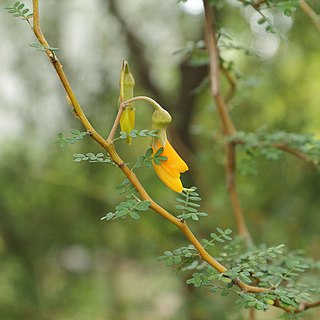
Sophora prostrata is commonly known as kōwhai, prostrate kōwhai or dwarf kōwhai and is endemic to the eastern South Island from Marlborough to the Waitaki Valley in New Zealand although most commonly found on the Banks Peninsula.
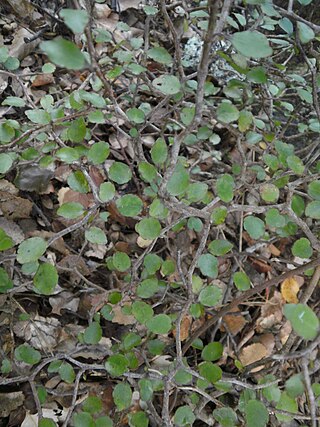
Raukaua anomalus is a species of shrub native to New Zealand. It is found throughout the country from lowland to montane shrub and forest areas.
Suaeda fruticosa is a species of flowering plant in the family Amaranthaceae. It is a small shrub, with very variable appearance over its wide range. It is a halophyte, and occurs in arid and semi-arid saltflats, salt marshes and similar habitats.
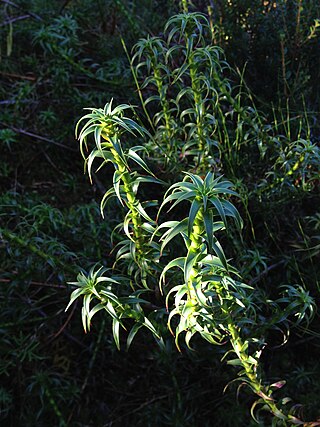
Richea gunnii, the bog candleheath or Gunns richea, is an endemic Tasmanian angiosperm. It is a dicot of the family Ericaceae and is found in Central, Western and North-east Tasmania.

Myrsine divaricata known as weeping māpou or weeping matipo, is a small tree up to 4 metres (13 ft) tall or often a shrub. It has a strongly divaricating habit with interlaced branched. The woody parts are stiff and pubescent when young. The small leathery simple leaves are borne on short petioles and may be slightly two lobed at the end. The very small yellow or reddish flowers may be borne singly or in small groups which mature into small purple, occasionally white, fruit.

Corokia cotoneaster is a flowering plant in the family Argophyllaceae was described by Étienne Fiacre Louis Raoul in 1846. This plant is commonly known as the wire-netting bush, korokio, or korokia-tarango. The word "Koriko" comes from the Māori language.
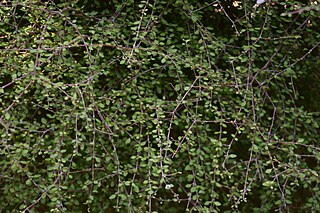
Coprosma virescens is an endemic New Zealand plant in the genus Coprosma of the family Rubiaceae. Its Māori name is mingimingi, a name which is also applied to closely related species such as C. dumosa, C. rhamnoides, C. propinqua and C. crassifolia. It is a small-leaved shrub or tree which grows 2 to 3 metres high. It has very slender, more or less glabrous divaricating branches. The small leaves are petiolate with petioles from 2mm to 5mm long. The leaves narrow suddenly at the petiole and may be up to 9 millimetres (0.35 in) long and 6 millimetres (0.24 in) wide with wavy margins or a few blunt teeth throughout South Island in lower montane forest and scrubland. The apetalous male flowers occur in axillary clusters of one to two on very short branches. Female flowers are found on their own at the ends of short branchlets.

Veronica strictissima, the Banks Peninsula hebe, is a species of flowering plant in the family Plantaginaceae. It is only found on Banks Peninsula in New Zealand.